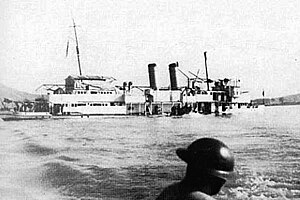USS Panay incident
| USS Panay incident | |||||||
|---|---|---|---|---|---|---|---|
| Part of the Second Sino-Japanese War | |||||||
 USS Panay sinking after Japanese air attack. Nanking, China. 12 December 1937. |
|||||||
|
|||||||
| Belligerents | |||||||
|
|
|
||||||
| Commanders and leaders | |||||||
|
|
unknown | ||||||
| Strength | |||||||
| 1 gunboat | 12 aircraft | ||||||
| Casualties and losses | |||||||
| 1 gunboat sunk 3 killed 43 wounded |
none | ||||||
|
|
|||||||
The USS Panay incident was a Japanese attack on the American gunboat Panay while it was anchored in the Yangtze River outside Nanking (now spelled Nanjing), China on 12 December 1937. Japan and the United States were not at war at the time. The Japanese claimed that they did not see the American flags painted on the deck of the gunboat, apologized, and paid an indemnity. Nevertheless, the attack and the subsequent Allison incident in Nanking caused U.S. opinion to turn against the Japanese.
A flat-bottomed craft built in Shanghai specifically for river duty, Panay served as part of the US Navy's Yangtze Patrol in the Asiatic Fleet, which was responsible for patrolling the Yangtze River to protect American lives and property in China.
After invading China in the summer of 1937, Japanese forces moved in on the city of Nanking (now known as Nanjing) in December. Panay evacuated the remaining Americans from the city on 11 December, bringing the number of people aboard to five officers, 54 enlisted men, four US embassy staff, and 10 civilians, including Universal News cameraman Norman Alley, Movietone News’ Eric Mayell, the New York Times's Norman Soong, Collier's Weekly correspondent Jim Marshall, La Stampa correspondent Sandro Sandri and Corriere della Sera correspondent Luigi Barzini Jr.
On the morning of the 12th, the Japanese air forces received information that fleeing Chinese forces were in the area in ten large steamers and a large number of junks and that they were between 12 and 25 mi (19 and 40 km) upstream from Nanking. While anchored upstream from Nanking, Panay and three Standard Oil tankers, Mei Ping, Mei An and Mei Hsia, came under attack from Japanese naval aircraft. Panay was hit by two of the eighteen 132 lb (60 kg) bombs dropped by three Yokosuka B4Y Type-96 bombers and strafed by nine Nakajima A4N Type-95 fighters.
...
Wikipedia
